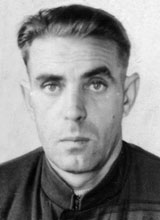Soviet Union

Major Aleksandr Semenovich Nikolayev
Soviet Union

Major Aleksandr Semenovich Nikolayev

1910 –
Aleksandr Nikolayev was born in 1910.
He graduated from flight school at Borisoglebskaya in 1931.
On 25 May 1936, he received a ”honorary” badge.
Kapitan Nikolayev took part in the Nomonhan Incident against Japan where he flew I-153s in 22 IAP between August and September 1939.
On 21 August 1939, kaptain Nikolayev claimed one Ki-27 destroyed, one shared with another pilot and a third ”in group” while Ki-27s were claimed individually by leitenant Aleksandr Piskunov (I-153), leitenant Vladimir Garanin (Polikarpov biplane) and leitenant Pavel Solov’yev (I-16).
Leitenant Ivan Rybkin (I-16) claimed a shared Ki-27 with another pilot (possibly kaptain Nikolayev). Leitenant Ivan Groshev (I-16) claimed one shared Ki-27 ”in group” at an unknown time and place while leitenant Aleksandr Suchkov (I-16) claimed one enemy bomber as a shared ”in group”.
While returning from a combat mission on 27 August, starshiy leitenant Viktor Rakhov, deputy CO of 22 IAP (I-16), was hit by rifle fire from the ground and seriously wounded by bullet in the stomach. He managed to land back at his own airfield but died in Chitinsky Hospital two days later. He had been in Mongolia since May and had claimed 11 victories and 9 shared during 68 combat missions and 15 air combats in the Khalkhin Gol Incident. He was decorated with a posthumous Gold Star of the Hero the Soviet Union and the Order of Lenin on 29 August 1939. He had also been decorated with the Mongolian Order of the Red Banner.
Kapitan Andrey Dekhtyarenko (I-16) claimed a Ki-27 (reported as a ”I-97”) over ”Square 279” and a second as a shared over ”Square 227” together with two other pilots. Kaptain Nikolayev claimed a Ki-27 while starshiy leitenant Nikolay Tochkov and starshiy leitenant Vasiliy Vuss both claimed a shared Ki-27 ”in group” (with Dekhtyarenko?).
Over Lake Buir-Nur on 2 September, three Ki-10s from the 33rd Sentai’s 2nd chutai led by 1st Lieutenant Soichi Okamoto, met some reported 30 I-16s. Okamoto claimed the unit’s first four victories of the Incident while Sergeant Major Shozo Saito in vain tried to ram one, but was instead obliged to force-lend.
They had met 22 IAP led by starshiy leitenant Fedor Cheremukhin. This experienced leader rightly reasoned that the I-16 tip 10 had significantly greater speed and firepower, and less manoeuvrability, and initiated the correct tactic for the fight: shooting from further away and avoiding close level manoeuvres. After the skirmish, his unit reported two downed Kawasaki Ki-10s for no own losses.
The encounter again escalated into an air battle. Excellent visibility allowed a great area to be observed, and each engagement was as visible as a flare by pilots on the ground; they immediately scrambled and flew across to assist their comrades. First to arrive were the 1st Sentai Ki-27. More Soviet fighters followed them, and the previous day’s events repeated themselves. The fight developed overhead Hamar-Daba Mountain and the Humurgin-Gol River, at the same levels that offered optimum performance to both sides: 3500 to 5000m. After 45 minutes that had witnessed over 250 machines fighting (175 of them Soviet), the sky grew quiet.
The Japanese admitted losing one Ki-27 when Sergeant Yukio Kijima (Sho-4) of the 1st Sentai was killed and suffering damage to four more fighters and totally claimed seven victories (four by Okamoto).
The Soviets fighters only lost one aircraft and totally claimed eight victories, six of them Ki-27s (reported as a ”I-97”). Known claiming pilots from 22 IAP were leitenant Petr Agafonov (I-153), who claimed a shared Ki-27 together with six other pilots north-west of Lake Uzur-Nur, leitenant Pavel Solntsev (I-16), who claimed two Ki-27s together with five other pilots over squares 531-533 and 633, kapitan Andrey Dekhtyarenko (I-16), who claimed a shared Ki-27 south-east of Lake Uzur-Nur together with three other pilots and kapitan Nikolayev (I-153), who claimed a Ki-27. Leitenant Aleksandr Piskunov (I-153), leitenant Vladimir Garanin (Polikarpov biplane) and mladshiy Viktor Ushakov (I-16) all claimed one shared Ki-27 ”in group”. Kapitan Mikhail Dolbyshev from 56 IAP (I-16) claimed one shared Ki-27 (”in group”).
He received the Order of the Red Banner on 17 November 1939.
From August 1942, mayor Nikolayev served in 845 IAP, flying Yak-7s.
Between 30 April 1943 and 16 June 1944, he worked as a test pilot in the repair department of the engineering and aviation service of 14 VA.
On 3 November 1944, he was decorated with the Order of the Red Star.
Nikolayev ended the war with 3 biplane victories.
Claims:
| Kill no. | Date | Time | Number | Type | Result | Plane type | Serial no. | Locality | Unit |
| 1939 | |||||||||
| 21/08/39 | 1/? | Ki-27 | Shared destroyed | I-153 | Nomonhan | 22 IAP | |||
| 1 | 21/08/39 | 1 | Ki-27 | Destroyed | I-153 | Nomonhan | 22 IAP | ||
| 21/08/39 | 1/2 | Ki-27 | Shared destroyed | I-153 | Nomonhan | 22 IAP | |||
| 2 | 27/08/39 | 1 | Ki-27 | Destroyed | I-153 | Nomonhan | 22 IAP | ||
| 3 | 02/09/39 | 1 | Ki-27 | Destroyed | I-153 | Nomonhan | 22 IAP |
Biplane victories: 3 and 2 shared destroyed.
TOTAL: 3 and 2 shared destroyed.
Sources:
All aces of Stalin 1936-1953 – Mikhail Bykov, 2014
Soviet Aces 1936-1953
Soviet Fighter Pilots 1936-1953 - Mikhail Bykov


